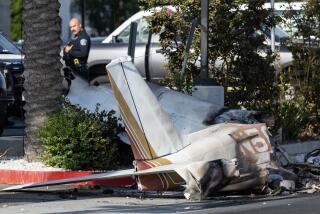Build It, Fly It: Too Risky?
As Dan Checkoway felt the wheels of his airplane lift off the runway, all he could do was laugh.
It wasn’t that something was so funny, it was a laugh of joy, knowing that after spending 30 months building his RV-7 plane himself, he was 1,000 feet in the air.
“Every night and long day sweating in the garage and hangar, this one minute made it all worth it,” said the 30-year-old Chino Hills computer programmer.
Checkoway’s plane is one of about 20,400 homebuilt aircraft registered with the Federal Aviation Administration. The Oshkosh, Wis.-based Experimental Aircraft Assn. says about 1,200 are added to the registry each year, exceeding factory-built small planes.
Homebuilders, as they’re known, will typically spend 3,000 hours constructing their planes, starting from the time they remove the fuselage from the plywood box until they take off.
But the world of homebuilt aviation was rocked Wednesday when a Harmon Rocket II, an aircraft similar to Checkoway’s RV-7, crashed into a Seal Beach neighborhood shortly after takeoff.
Ross Kay Anderson, a 62-year-old retired Navy fighter pilot, was killed in the accident. Three people on the ground were treated at hospitals and released.
After the crash, Checkoway and other homebuilt aircraft enthusiasts began exchanging e-mails on their message boards, nervous that nonaviators would think homebuilders were cheating death by flying rickety aircraft lacking safety standards.
But homebuilders say they feel safer flying their own planes, because they are there when every rivet is driven and every wire attached.
Dick Knapinski, a spokesman for the Experimental Aircraft Assn., said most homebuilders are experienced pilots and engineers. “None of those people have any interest in being a statistic,” Knapinski said. “If you’re going to be transporting yourself 3,000 feet up in the air, and flying at 150 mph, you’re going to make very sure that every bolt and connection is made correctly.”
But therein can lie the problem, some experts say.
“It’s nice to feel passionate about assembling your own plane, but there’s a certain value to having it done by skilled and regulated professionals,” said Richard Aboulafia of the Teal Group, a Fairfax, Va.-based aviation research firm. “You can be the best pilot in the world and have incredible motivation, but a professional riveter will know more about his craft.”
In the last 10 years, 817 people have died in homebuilt-plane crashes, according to the National Transportation Safety Board’s database.
Before Wednesday’s crash, there were three accidents involving the 44 Harmon Rocket IIs registered with the FAA, none fatal. Harmon officials said 210 kits have been sold since they came on the market in 1993.
An accident near Sacramento in 1998 was due to inadequate pilot inspection. A Houston accident in 2000 was due to a disconnected air hose. In 2001, a missing bolt and nut forced the landing of a newly homebuilt Harmon Rocket in Perris.
To ensure no corners are cut, the FAA requires homebuilders to document the plane’s construction with photographs or in a written log. Before the plane can take off, it must pass an FAA inspection.
Checkoway has logged every step of his plane-building progress on his website, rvproject .com. The site contains more than 5,000 photos, detailing such progress as completing his horizontal stabilizer on Sept. 28, 2001. His entry on Nov. 15, 2003, is titled “More fun with 5/8” tubing.”
“The detail that people put in, it’s an extension of your personality to a large degree,” Checkoway said.
Though Checkoway did not know Anderson, he saw his red and white, two-seater parked in the same spot at Chino Airport each day.
“It was a beautiful plane, one of the nicest around,” Checkoway said.
Anderson was known in aviation circles as an expert pilot, having logged more than 4,000 hours of flight time. After his stint in the Navy flying F-4 and F-8 fighter planes, he became a “Top Gun” instructor and later headed several engineering and manufacturing firms.
He spent more than a decade constructing the Harmon Rocket in his Rancho Palos Verdes garage before completing it in May 2003, and was not reluctant about flying the two-seater across the country. He recently returned from a trip to Yellowstone National Park with his wife, Susan -- he in front, she in back.
Anderson commuted daily by plane from Torrance to the vintage aircraft-restoration business in Chino he had bought eight months ago. He had plans to travel this month to Oshkosh for an annual experimental aircraft festival.
“He was very meticulous with every detail of the aircraft,” said Christina Phillips, a spokeswoman for Harmon Rocket and a friend of Anderson.
Colleagues said because Anderson’s standards were so exacting, they speculate the crash may have been caused by a medical problem. However, FAA spokesman Donn Walker said there is no evidence of a medical emergency, and a preliminary cause might not be determined until the end of the year.
The crash was topic one at the monthly meeting Thursday of Long Beach’s Experimental Aircraft Assn.
“Some people knew him, some did not, but still he’s a brother in aviation,” said chapter president George McDaniel.
“Ross Anderson died doing something that we all love.”
More to Read
Inside the business of entertainment
The Wide Shot brings you news, analysis and insights on everything from streaming wars to production — and what it all means for the future.
You may occasionally receive promotional content from the Los Angeles Times.










